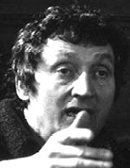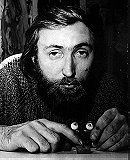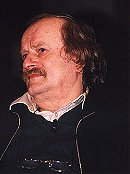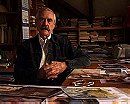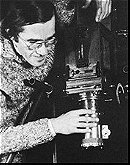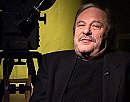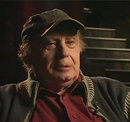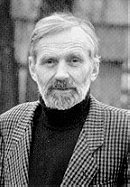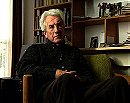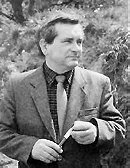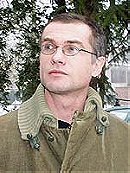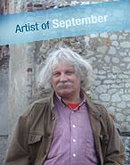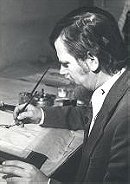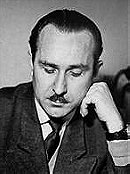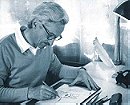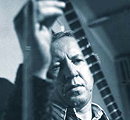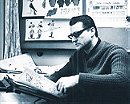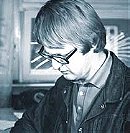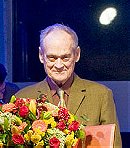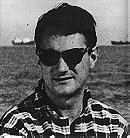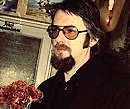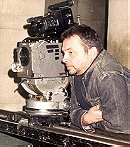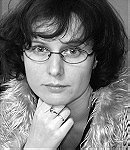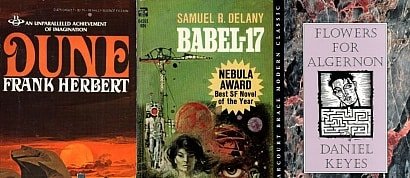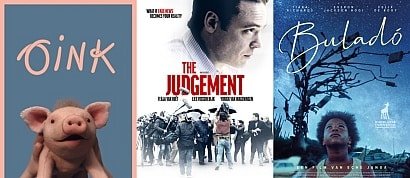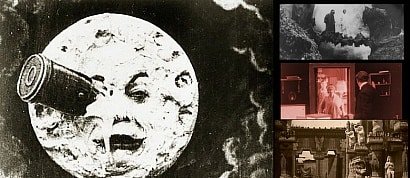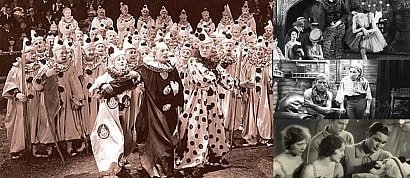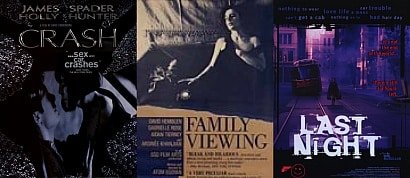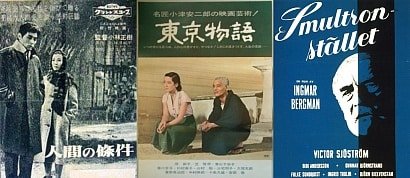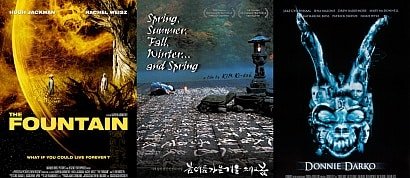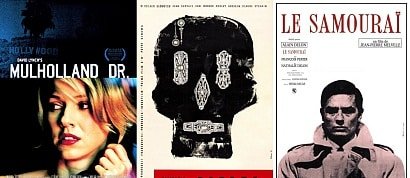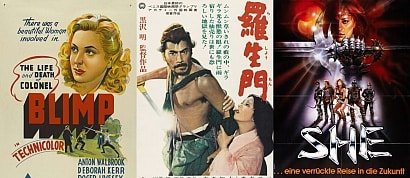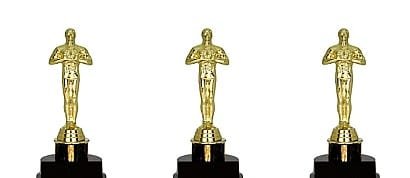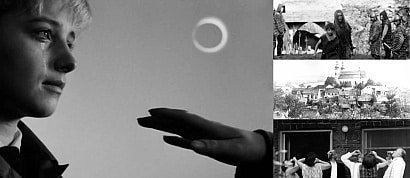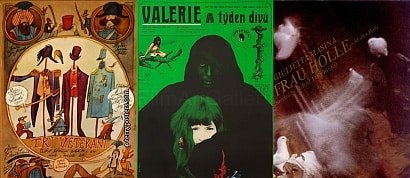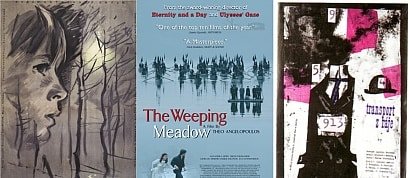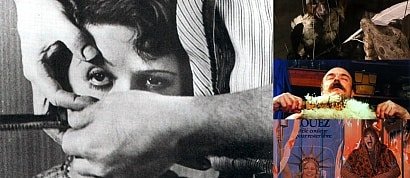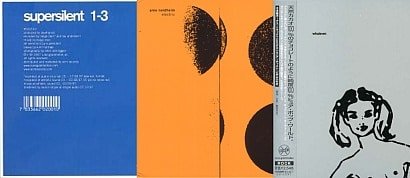Animators from Poland
Sort by:
Showing 41 items
Rating:
List Type:
Jan Leniča (4 January 1928, Poznań, Poland - 5 October 2001, Berlin) was a Polish graphic designer and cartoonist.
A graduate of the Architecture Department of Warsaw Polytechnic, Lenica became a poster illustrator and a collaborator on the early animation films of Walerian Borowczyk. From 1963 - 1986 he lived and worked in France, while from 1987 he lived and worked in Berlin. He was a professor of graphic, poster, animated cartoon for many years at German high schools and the first professor of the animation class at the University of Kassel, Germany, in 1979. He used cut-out stop motion animation in his numerous films, which included two features: Adam 2 (1968) and Ubu et la grande gidouille (1976, but released in France only in 1979).
* 1957 - Nagrodzone Uczucia (Love Requited)
* 1957 - Byl Sobie Raz (Once There Was)
* 1958 - Dom (House)
* 1961 - Italia '61
* 1961 - Nowy Janko Muzykant
* 1963 - Labirynt
* 1965 - La Femme Fleur
* 1965 - A
* 1970 - Adam 2
* 1987 - Ubu et la Grande Gidouille
* 2001 - Wyspa R.O.
A graduate of the Architecture Department of Warsaw Polytechnic, Lenica became a poster illustrator and a collaborator on the early animation films of Walerian Borowczyk. From 1963 - 1986 he lived and worked in France, while from 1987 he lived and worked in Berlin. He was a professor of graphic, poster, animated cartoon for many years at German high schools and the first professor of the animation class at the University of Kassel, Germany, in 1979. He used cut-out stop motion animation in his numerous films, which included two features: Adam 2 (1968) and Ubu et la grande gidouille (1976, but released in France only in 1979).
* 1957 - Nagrodzone Uczucia (Love Requited)
* 1957 - Byl Sobie Raz (Once There Was)
* 1958 - Dom (House)
* 1961 - Italia '61
* 1961 - Nowy Janko Muzykant
* 1963 - Labirynt
* 1965 - La Femme Fleur
* 1965 - A
* 1970 - Adam 2
* 1987 - Ubu et la Grande Gidouille
* 2001 - Wyspa R.O.
Valerie's rating:


Walerian Borowczyk (September 2, 1923 - February 3, 2006) was a Polish film director. He directed 40 films between 1946 and 1988.
Born in Kwilcz, near Poznań, he studied painting at the Academy of Fine Arts in Kraków, then devoted himself to painting and lithography, including the creation of posters for the cinema, which earned him a national prize in 1953. In 1959, he settled in Paris.
His early films were surreal animations, some only a few seconds long, including several comic abecedaria. His most acclaimed early films were Był sobie raz (Time Upon a Once) (1957) and Dom (House) (1958, with Jan Lenica). In 1959, he worked with Chris Marker for Les Astronautes. Major works of this period include the stop motion film Renaissance (1963), which uses reverse motion to depict various destroyed objects (a prayer book, a stuffed toy, etc.) re-assembling themselves, only to be destroyed again when the last object (a bomb) is complete, and the nightmarish Jeux des anges (1964), selected by Terry Gilliam as one of the ten best animated films of all time. In 1967, he directed his first animated feature film, Théâtre de Monsieur & Madame Kabal: un film dessiné pour les adultes (Mr. and Mrs. Kabal's Theatre).
Borowczyk moved into live-action feature film with Goto, l'île d'amour (Goto, Isle of Love) (1968) and Blanche (1971), both tales of illicit love thwarted by jealous husbands, and both starring his own wife, Ligia Branice. One of his most appreciated films of this period, Dzieje grzechu (A Story of Sin) (1975), which was nominated for Palme d'or, is an adaptation of a Polish literary classic by Stefan Żeromski. Like his 1966 short film Rosalie (a Guy de Maupassant adaptation and a Silver Bear winner), Dzieje grzechu had successfully rendered the themes of seduction and infanticide. Contes immoraux (Immoral Tales) (1974) and his later work, including Interno di un convento (Behind Convent Walls) (1977) (inspired by Promenades dans Rome of Stendhal) and Cérémonie d'amour (Rites of Love) (1988) have been controversial, lauded by some for their unique surrealist vision and derided by others as contentless pornography. Especially, La Bête (The Beast, 1975)(based on the story Lokis by Prosper Mérimée and originally conceived in 1972 as a film on its own, but then in 1974 as the fifth story in Contes immoraux) was seen by many as a decline in the director's career after Dzieje grzechu, except in France, where it was hailed by prominent critics such as Ado Kyrou.
In 1981, he made Docteur Jekyll et les femmes (Blood of Dr Jekyll), a version of the Jekyll and Hyde story starring Udo Kier and Patrick Magee and depicting Jekyll's transformation as a violent rebellion against the Victorian morality. In his 1988 book Nightmare Movies, Kim Newman described the film as "dark, misanthropic and interestingly offensive". He made a brief return to animation with his 1984 short film Scherzo infernal. In 1987, he directed Emmanuelle 5, an installment of the Emmanuelle series, that was also released in a hardcore video-only version. He was unhappy with the project due to a dispute concerning the casting of lead actress Monique Gabrielle. In 1988 and 1990, he directed four episodes for the series Série rose: Les Chefs d’œuvre de la littérature érotique on M6.
Many of Borowczyk's films use historical settings, including Ars Amandi: l'arte di amare (The Art of Love) (1983), set in the time of Ovid (and featuring the poet as a character); Blanche, set during the Middle Ages; and three of the four episodes in Contes immoraux, set respectively in the nineteenth century, the sixteenth century, and the Borgia papacy.
A number of his films (like the "tale" La Marée (The Tide) in Contes immoraux, the 1976 La Marge (The Streetwalker), the episode Marceline in Les Héroïnes du mal: Margherita, Marceline, Marie (Immoral Women) (1979), and Cérémonie d'amour were based on stories by André Pieyre de Mandiargues. A less usual product of this cooperation was Une collection particulière of 1973, a representation of Borowczyk's collection of pornographic items, with Mandiargues having written (and read) the narration. His 1980 film Lulu was an onscreen adaptation of the play by Frank Wedekind.
Borowczyk was the author of two books; Anatomia diabła (Anatomy of Devil) (1992) and Moje polskie lata (My Polish Years) (2002).
He died of heart failure in Paris in 2006.
Born in Kwilcz, near Poznań, he studied painting at the Academy of Fine Arts in Kraków, then devoted himself to painting and lithography, including the creation of posters for the cinema, which earned him a national prize in 1953. In 1959, he settled in Paris.
His early films were surreal animations, some only a few seconds long, including several comic abecedaria. His most acclaimed early films were Był sobie raz (Time Upon a Once) (1957) and Dom (House) (1958, with Jan Lenica). In 1959, he worked with Chris Marker for Les Astronautes. Major works of this period include the stop motion film Renaissance (1963), which uses reverse motion to depict various destroyed objects (a prayer book, a stuffed toy, etc.) re-assembling themselves, only to be destroyed again when the last object (a bomb) is complete, and the nightmarish Jeux des anges (1964), selected by Terry Gilliam as one of the ten best animated films of all time. In 1967, he directed his first animated feature film, Théâtre de Monsieur & Madame Kabal: un film dessiné pour les adultes (Mr. and Mrs. Kabal's Theatre).
Borowczyk moved into live-action feature film with Goto, l'île d'amour (Goto, Isle of Love) (1968) and Blanche (1971), both tales of illicit love thwarted by jealous husbands, and both starring his own wife, Ligia Branice. One of his most appreciated films of this period, Dzieje grzechu (A Story of Sin) (1975), which was nominated for Palme d'or, is an adaptation of a Polish literary classic by Stefan Żeromski. Like his 1966 short film Rosalie (a Guy de Maupassant adaptation and a Silver Bear winner), Dzieje grzechu had successfully rendered the themes of seduction and infanticide. Contes immoraux (Immoral Tales) (1974) and his later work, including Interno di un convento (Behind Convent Walls) (1977) (inspired by Promenades dans Rome of Stendhal) and Cérémonie d'amour (Rites of Love) (1988) have been controversial, lauded by some for their unique surrealist vision and derided by others as contentless pornography. Especially, La Bête (The Beast, 1975)(based on the story Lokis by Prosper Mérimée and originally conceived in 1972 as a film on its own, but then in 1974 as the fifth story in Contes immoraux) was seen by many as a decline in the director's career after Dzieje grzechu, except in France, where it was hailed by prominent critics such as Ado Kyrou.
In 1981, he made Docteur Jekyll et les femmes (Blood of Dr Jekyll), a version of the Jekyll and Hyde story starring Udo Kier and Patrick Magee and depicting Jekyll's transformation as a violent rebellion against the Victorian morality. In his 1988 book Nightmare Movies, Kim Newman described the film as "dark, misanthropic and interestingly offensive". He made a brief return to animation with his 1984 short film Scherzo infernal. In 1987, he directed Emmanuelle 5, an installment of the Emmanuelle series, that was also released in a hardcore video-only version. He was unhappy with the project due to a dispute concerning the casting of lead actress Monique Gabrielle. In 1988 and 1990, he directed four episodes for the series Série rose: Les Chefs d’œuvre de la littérature érotique on M6.
Many of Borowczyk's films use historical settings, including Ars Amandi: l'arte di amare (The Art of Love) (1983), set in the time of Ovid (and featuring the poet as a character); Blanche, set during the Middle Ages; and three of the four episodes in Contes immoraux, set respectively in the nineteenth century, the sixteenth century, and the Borgia papacy.
A number of his films (like the "tale" La Marée (The Tide) in Contes immoraux, the 1976 La Marge (The Streetwalker), the episode Marceline in Les Héroïnes du mal: Margherita, Marceline, Marie (Immoral Women) (1979), and Cérémonie d'amour were based on stories by André Pieyre de Mandiargues. A less usual product of this cooperation was Une collection particulière of 1973, a representation of Borowczyk's collection of pornographic items, with Mandiargues having written (and read) the narration. His 1980 film Lulu was an onscreen adaptation of the play by Frank Wedekind.
Borowczyk was the author of two books; Anatomia diabła (Anatomy of Devil) (1992) and Moje polskie lata (My Polish Years) (2002).
He died of heart failure in Paris in 2006.
Valerie's rating:


Kucia, born in Poland in 1942, studied painting and art design at Cracow’s Art Academy and has produced thirteen animation films since 1972, in which he was responsible for the script, direction and animation, always enjoying working with representatives of the experimental polish music scene. His films were screened and received awards at many international festivals (e.g. Cannes, Oberhausen).
His films are not only complex and ambiguous technically. As far as form is concerned, they move between a reduced narrative-graphic approach and partly expressive abstraction. Atmospherically his works, often characterised as "emotional", move between distanced observation, poetry and existential exasperation, as regards content one can detect state descriptions, as well as metaphorically formulated statements (about life in general, the political system, the human nature, etc.).
Apart from his role as "avant-gardist of animation film" who consistently developed a personal language of images against the usual trends of animation film festivals, Jerzy Kucia is an exceptionally important international ambassador and supporter of animation film. For many years he represented Poland in the international ASIFA (for several years as vice president) and facilitated communication across the boundaries long before the collapse of the old political systems
Since 1980 he has directed the Department of Animation Film at Cracow’s Art Academy, where he hands on his stubborn attitude.
His films are not only complex and ambiguous technically. As far as form is concerned, they move between a reduced narrative-graphic approach and partly expressive abstraction. Atmospherically his works, often characterised as "emotional", move between distanced observation, poetry and existential exasperation, as regards content one can detect state descriptions, as well as metaphorically formulated statements (about life in general, the political system, the human nature, etc.).
Apart from his role as "avant-gardist of animation film" who consistently developed a personal language of images against the usual trends of animation film festivals, Jerzy Kucia is an exceptionally important international ambassador and supporter of animation film. For many years he represented Poland in the international ASIFA (for several years as vice president) and facilitated communication across the boundaries long before the collapse of the old political systems
Since 1980 he has directed the Department of Animation Film at Cracow’s Art Academy, where he hands on his stubborn attitude.
Valerie's rating:


Julian Antonisz, born Julian Józef Antoniszczak (November 8, 1941 - January 31, 1987), was a Polish avant-garde filmmaker, artist, animator, scriptwriter, composer, and inventor.
Best known as an inventor and promoter of his unique animation technique called non-camera. Sun: A Non-Camera Film 1977 (Słońce - film bez kamery) was his first all non-camera movie, although the technique has been used also in Antonisz's earlier productions. The idea after the tehnique was to paint or scratch the images directly onto the movie tape instead of using a camcorder. Usually one second of movie uses 24 frames. For example, his debut film Phobia 1967, lasts 11 minutes. 660 seconds times 24 frames gives us 15,840 images that had to be painted.
Antonisz famous of his mechanical skills, has constructed numerous accessories supporting the creation of non-camera movies. Antoniszograf fazujący was a machine which scratched a set of frames, with a fluid transition between the two following images. Another invention was a prototype of chropograf (could be translated as scabrographe), which created an image with distinctive levels of roughness, allowing the blind to recognize shapes presented on the picture.
His most awarded work is How a Sausage Dog Works 1971 (Jak działa jamniczek).
Best known as an inventor and promoter of his unique animation technique called non-camera. Sun: A Non-Camera Film 1977 (Słońce - film bez kamery) was his first all non-camera movie, although the technique has been used also in Antonisz's earlier productions. The idea after the tehnique was to paint or scratch the images directly onto the movie tape instead of using a camcorder. Usually one second of movie uses 24 frames. For example, his debut film Phobia 1967, lasts 11 minutes. 660 seconds times 24 frames gives us 15,840 images that had to be painted.
Antonisz famous of his mechanical skills, has constructed numerous accessories supporting the creation of non-camera movies. Antoniszograf fazujący was a machine which scratched a set of frames, with a fluid transition between the two following images. Another invention was a prototype of chropograf (could be translated as scabrographe), which created an image with distinctive levels of roughness, allowing the blind to recognize shapes presented on the picture.
His most awarded work is How a Sausage Dog Works 1971 (Jak działa jamniczek).
Valerie's rating:


Action artist, performance artist, scenery designer, creator of animated films and stained glass. Born April 15, 1944, in Garwolin; resides in Komorow near Warsaw.
Kalina was a student in the Painting Department of the Academy of Fine Arts in Warsaw between 1965 and 1971. He obtained his diploma in the studio of Stefan Gierowski. In 1989 he was invited by the same department of his alma mater to lead a "guest studio," which he lead for three semesters during 1990 and 1991.
Kalina's oeuvre encompasses a number of separate, varied activities to which the artist assigns his own names. These include "ritual actions," "determinants" and "living pictograms." The artist developed his individual language of forms early on, selecting and experimenting with the materials and objects that would eventually come to characterize his art, and delineating his sphere of interests. He has focused on issues of existential enslavement and limitation, which he strives to deconstruct through artistic processes that he uses to confront everyday realities in a direct manner (Skrepowanie / Discomfort, Victory Square, Warsaw, 1971; Przystanek taxi / Taxi Stop, Salt Square, Wroclaw, 1972; Wykop / Excavation, Wigilia / Christmas Eve, action art pieces at the Pawel Freisler Gallery, Warsaw, 1972; Bialy most / White Bridge, Wroclaw, 1974; Obchod / Inspection, Repassage Gallery, Warsaw, 1975; Przejscie / Crossing, corner of Mazowiecka and Swietokrzyska streets, Warsaw, 1977). While Poland was under Martial, Kalina adopted an unequivocally oppositional stance. Given his unrestrained, expansive tendencies as well as his links to the Catholic Church, his work had to generate social resonance of unheard of proportions in the realm of public art, which indeed it did. He produced works based on "official" commissions from Catholic Church authorities, e.g. visual elements and scenery for religious ceremonies (outdoor altars during the pilgrimages to Poland of Pope John Paul II in 1987 and 1991; visual design for the funeral of Father Jerzy Popieluszko (1984) and the design for the same priest's tomb located alongside St. Stanislaus Kostka Church in Warsaw (1986), a monument shaped like a cross on the Vistula River dam in Wloclawek, 1991). He also created works based on government commissions, among them the design for the chapel in Belvedere Palace (1992). More recently he has been creating objects in sheet metal and designing stained glass windows.
Simultaneously, since 1973, Kalina has been creating animated films. He has authored more than a dozen films that have won him numerous awards at Polish and international festivals. He also designs and directs original theatre productions that are presented on some of the country's professional stages (Pielgrzymi i tulacze / Pilgrims and Exiles, premiered at the Teatr Studio / Studio Theatre in 1989, then performed numerous times in Poland and abroad; Katapulta / Catapult, Teatr Maly / Little Theatre, Warsaw, 1993).
Kalina was a student in the Painting Department of the Academy of Fine Arts in Warsaw between 1965 and 1971. He obtained his diploma in the studio of Stefan Gierowski. In 1989 he was invited by the same department of his alma mater to lead a "guest studio," which he lead for three semesters during 1990 and 1991.
Kalina's oeuvre encompasses a number of separate, varied activities to which the artist assigns his own names. These include "ritual actions," "determinants" and "living pictograms." The artist developed his individual language of forms early on, selecting and experimenting with the materials and objects that would eventually come to characterize his art, and delineating his sphere of interests. He has focused on issues of existential enslavement and limitation, which he strives to deconstruct through artistic processes that he uses to confront everyday realities in a direct manner (Skrepowanie / Discomfort, Victory Square, Warsaw, 1971; Przystanek taxi / Taxi Stop, Salt Square, Wroclaw, 1972; Wykop / Excavation, Wigilia / Christmas Eve, action art pieces at the Pawel Freisler Gallery, Warsaw, 1972; Bialy most / White Bridge, Wroclaw, 1974; Obchod / Inspection, Repassage Gallery, Warsaw, 1975; Przejscie / Crossing, corner of Mazowiecka and Swietokrzyska streets, Warsaw, 1977). While Poland was under Martial, Kalina adopted an unequivocally oppositional stance. Given his unrestrained, expansive tendencies as well as his links to the Catholic Church, his work had to generate social resonance of unheard of proportions in the realm of public art, which indeed it did. He produced works based on "official" commissions from Catholic Church authorities, e.g. visual elements and scenery for religious ceremonies (outdoor altars during the pilgrimages to Poland of Pope John Paul II in 1987 and 1991; visual design for the funeral of Father Jerzy Popieluszko (1984) and the design for the same priest's tomb located alongside St. Stanislaus Kostka Church in Warsaw (1986), a monument shaped like a cross on the Vistula River dam in Wloclawek, 1991). He also created works based on government commissions, among them the design for the chapel in Belvedere Palace (1992). More recently he has been creating objects in sheet metal and designing stained glass windows.
Simultaneously, since 1973, Kalina has been creating animated films. He has authored more than a dozen films that have won him numerous awards at Polish and international festivals. He also designs and directs original theatre productions that are presented on some of the country's professional stages (Pielgrzymi i tulacze / Pilgrims and Exiles, premiered at the Teatr Studio / Studio Theatre in 1989, then performed numerous times in Poland and abroad; Katapulta / Catapult, Teatr Maly / Little Theatre, Warsaw, 1993).
Valerie's rating:


Witold Giersz was born on 26th February 1927 in Poraj, Poland. During World War II he was a member of Polish resistance movement. Having graduated from high school in 1948, Giersz studied economy in Katowice. Two years later he began working as an animator in a newly established animated cartoon co-operation "Slask", known today as Animated Cartoon Studio in Bielsko-Biala.
When delegated to Warsaw in 1956, Giersz established and trained a group of artists that was restructured into the current Miniature Film Studio after two years. There, the so-called Polish school of animation was born in the 1960s. In 1972 he started his studies in Film Directing Department at Polish National Film, Television and Theatre School in Lodz, and obtained a diploma in 1977. Between 1985 and 1992 Giersz worked for Animated Films TV Studio in Poznan as a director and an artistic executive.
Witold Giersz has made about 60 short animated films, for which he has received over 70 awards and distinctions at film festivals all around the world.
When delegated to Warsaw in 1956, Giersz established and trained a group of artists that was restructured into the current Miniature Film Studio after two years. There, the so-called Polish school of animation was born in the 1960s. In 1972 he started his studies in Film Directing Department at Polish National Film, Television and Theatre School in Lodz, and obtained a diploma in 1977. Between 1985 and 1992 Giersz worked for Animated Films TV Studio in Poznan as a director and an artistic executive.
Witold Giersz has made about 60 short animated films, for which he has received over 70 awards and distinctions at film festivals all around the world.
Valerie's rating:


Born in 1936 in Warsaw, Piotr Kamler, graduate of the Academy of the Art schools of Warsaw, continue its studies in the Art schools of Paris in 1959. While arriving at Paris, it is put in contact with the Research center of the ORTF directed by Pierre Scheaffer where it collaborates with the concrete musicians like Xenakis, Bayle, Malec and where it carries out several court-measurings of research.
Since this date Piotr Kamler saw in Paris and in Warsaw but it is in France that it carries out its films.
As of its foundation, in 1960. the Research center of the O.R.T.F., directed and animated by Pierre Schaeffer, gives his support for the authors eager to join the study reports/ratios of the sound and image. This research was based mental is governed by an experimental step which continues, as from 1942, by successive stages: Studio of Test, Groups Concrete music and Centers Studies on the Radio-TV Between the basic research and the professional production, a common denominator: artistic creation. Already, the interdependence of traditional arts and the novel methods of communication attracts, quickly, of many painters and graphic designers. Some will improvise scenario writers in order to be initiated with electronic fakings, optics or, of cartoon film. Little by little, are worked out thus original, prototype works of a new language.
“The true researcher, by definition, does not recruit himself”, said Pierre Schaeffer, “it arrives”. Piotr Kamler was these.
Piotr Kamler carries out its films with the manner of a craftsman of the Middle Ages. Manufactured its own hands, its table of animation is a rest on which it works out slowly, by successive approaches, an object that it would like perfect. Design with the completion - drawing, taken sights, assembly - it is the work of a recluse.
Piotr Kamler is locked up in the world of the imaginary one. Or rather as he likes to repeat it, a real-world, whose he does nothing but visualize the existence. A world fantastic, populated odd characters and situations, a world baroque made of matters, colors and shades major; electric, complex and, often, contradictory world, which, of a logical relentless interns, points out ours curiously to us. Its fables, like “araignéléphant It”, “Delicious catastrophe” or “Heart of help”, S `endeavor to show that nothing is lost, that the improbable one can be possible…
To give a plastic reality to these strange stories, it is what worries, above all, Piotr Kamler: the search of processes and materials, the visual quality of the spectacle. Intense colors and lights mouvantest emphasize the presence of the characters and the decorations. The music is certainly the only field where Piotr Kamler agrees to establish the permanent bases of an artistic collaboration. The experimental music, the search for new sonorities, reveal an empirical step to him near to his.
In addition to the prices obtained in various international festivals Piotr Kamler was named Chevalier about Arts and Letters in 1975.
Since this date Piotr Kamler saw in Paris and in Warsaw but it is in France that it carries out its films.
As of its foundation, in 1960. the Research center of the O.R.T.F., directed and animated by Pierre Schaeffer, gives his support for the authors eager to join the study reports/ratios of the sound and image. This research was based mental is governed by an experimental step which continues, as from 1942, by successive stages: Studio of Test, Groups Concrete music and Centers Studies on the Radio-TV Between the basic research and the professional production, a common denominator: artistic creation. Already, the interdependence of traditional arts and the novel methods of communication attracts, quickly, of many painters and graphic designers. Some will improvise scenario writers in order to be initiated with electronic fakings, optics or, of cartoon film. Little by little, are worked out thus original, prototype works of a new language.
“The true researcher, by definition, does not recruit himself”, said Pierre Schaeffer, “it arrives”. Piotr Kamler was these.
Piotr Kamler carries out its films with the manner of a craftsman of the Middle Ages. Manufactured its own hands, its table of animation is a rest on which it works out slowly, by successive approaches, an object that it would like perfect. Design with the completion - drawing, taken sights, assembly - it is the work of a recluse.
Piotr Kamler is locked up in the world of the imaginary one. Or rather as he likes to repeat it, a real-world, whose he does nothing but visualize the existence. A world fantastic, populated odd characters and situations, a world baroque made of matters, colors and shades major; electric, complex and, often, contradictory world, which, of a logical relentless interns, points out ours curiously to us. Its fables, like “araignéléphant It”, “Delicious catastrophe” or “Heart of help”, S `endeavor to show that nothing is lost, that the improbable one can be possible…
To give a plastic reality to these strange stories, it is what worries, above all, Piotr Kamler: the search of processes and materials, the visual quality of the spectacle. Intense colors and lights mouvantest emphasize the presence of the characters and the decorations. The music is certainly the only field where Piotr Kamler agrees to establish the permanent bases of an artistic collaboration. The experimental music, the search for new sonorities, reveal an empirical step to him near to his.
In addition to the prices obtained in various international festivals Piotr Kamler was named Chevalier about Arts and Letters in 1975.
Valerie's rating:


Zbigniew Rybczyński (born January 27, 1949) is an Academy Award winning Polish filmmaker who has won numerous prestigious industry awards both in the United States and internationally. He was also a teacher of cinematography, and digital cinematography. Currently he is a researcher of blue and greenscreen compositing technology at Ultimatte Corporation.
Rybczyński was born in Łódź, Poland. He was studying cinematography in the then world-famous Łódź Film School (PWSFTviT). He began his professional career working as a cinematographer for young directors of his generation. His films from that period include: The Talk (Rozmowa- TV) and Gropingly (Po Omacku) by Piotr Andrejew, Videocassette (Wideokaseta) by Filip Bajon, Wanda Gościmińska włókniarka by Wojciech Wiszniewski and a feature movie by Grzegorz Królikiewicz Dancing Hawk (Tańczący Jastrząb).
Rybczyński was also active in an avant-garde group "Warsztat Formy Filmowej", and had cooperated with "Se-Ma-For" Studios in Łódź, where his author movies were set, including: Plamuz 1973, Zupa 1974, Nowa książka 1975 and Tango 1980. Tango was his big success, winning the Oscar Award for Best Animated Short in 1983.
He is a recognized pioneer in HDTV technology. In 1990, he produced the HDTV program The Orchestra for the Japanese market. This program won numerous awards (the Emmy Award for "Outstanding Achievement in Special Visual Effects"). The program, created in HDTV, was broadcast in standard resolution by PBS as part of their Great Performances series in the U.S. As HDTV it was not widely available to viewers until a decade later. Segments of this program are regularly featured on the Classic Arts Showcase channel in the U.S.
Rybczynski has created many music videos for artists such as Art of Noise, Mick Jagger, Simple Minds, Pet Shop Boys, Chuck Mangione, The Alan Parsons Project, Yoko Ono, Lou Reed, Supertramp, Rush, Propaganda, Lady Pank and also for John Lennon's Imagine.
Rybczyński was born in Łódź, Poland. He was studying cinematography in the then world-famous Łódź Film School (PWSFTviT). He began his professional career working as a cinematographer for young directors of his generation. His films from that period include: The Talk (Rozmowa- TV) and Gropingly (Po Omacku) by Piotr Andrejew, Videocassette (Wideokaseta) by Filip Bajon, Wanda Gościmińska włókniarka by Wojciech Wiszniewski and a feature movie by Grzegorz Królikiewicz Dancing Hawk (Tańczący Jastrząb).
Rybczyński was also active in an avant-garde group "Warsztat Formy Filmowej", and had cooperated with "Se-Ma-For" Studios in Łódź, where his author movies were set, including: Plamuz 1973, Zupa 1974, Nowa książka 1975 and Tango 1980. Tango was his big success, winning the Oscar Award for Best Animated Short in 1983.
He is a recognized pioneer in HDTV technology. In 1990, he produced the HDTV program The Orchestra for the Japanese market. This program won numerous awards (the Emmy Award for "Outstanding Achievement in Special Visual Effects"). The program, created in HDTV, was broadcast in standard resolution by PBS as part of their Great Performances series in the U.S. As HDTV it was not widely available to viewers until a decade later. Segments of this program are regularly featured on the Classic Arts Showcase channel in the U.S.
Rybczynski has created many music videos for artists such as Art of Noise, Mick Jagger, Simple Minds, Pet Shop Boys, Chuck Mangione, The Alan Parsons Project, Yoko Ono, Lou Reed, Supertramp, Rush, Propaganda, Lady Pank and also for John Lennon's Imagine.
Valerie's rating:


8.05.1929 in Leningrad. Director of animated films, stage designer, screenwriter.
In the period 1960-1966 related to the Cartoon Film Studio in Bielsko-Biala, from 1966 - with Miniatur Film studio in Warsaw, 1982-84 - Lecturer at the University of Villanova in the U.S.. SFP member since 1966; 1987-1991 - Member of the Committee of Cinematography, member of the World Association of Soldiers AK (Cross brave, Cross AK).
Prize winner of the festival in Krakow, Vienna, Edinburgh, Mar del Plata, Bordigherze, Barcelona.
After 1968, his films made in Warsaw. Died in 2001
In the period 1960-1966 related to the Cartoon Film Studio in Bielsko-Biala, from 1966 - with Miniatur Film studio in Warsaw, 1982-84 - Lecturer at the University of Villanova in the U.S.. SFP member since 1966; 1987-1991 - Member of the Committee of Cinematography, member of the World Association of Soldiers AK (Cross brave, Cross AK).
Prize winner of the festival in Krakow, Vienna, Edinburgh, Mar del Plata, Bordigherze, Barcelona.
After 1968, his films made in Warsaw. Died in 2001
Valerie's rating:


Ryszard Czekała born in Bydgoszcz in 1941. A director and a screenplay writer of animated and feature films. He finished the departament of Painting and Graphics at the Cracow Academy of Fine Arts in 1966, and department of Film Directing at State Film School in Lodz in 1976. He is a co-founder of Cracow Animated Films Studio. He is one of the most important artist of the Polish animation school.
Andrzej Czeczot (born 27 October 1933 in Cracow) - Polish graphic artist and creator of animated films. The most famous as the author of satirical drawings and classic cartoons, an important area of his work is also useful graphic design (posters, posters, book covers and illustrations).
A graduate of the Academy of Fine Arts in Krakow (in Katowice, he studied at the Department of Graphic Arts, the Krakow branch of the Academy of Fine Arts, Diploma in 1957). Interned during martial law. From 1982 to 1997 he lived and worked in the U.S.. In addition to Janusza Cabbages and Raphael Olbińskiego one of the few Polish graphic artists who have made a genuine career there.
Debuted in the weekly pins in 1956. In PRL drawings published in various titles, began a collaboration with the German and American Pardon The New Yorker. During his exile zamieszczały drawings also The New York Times and the Wall Street Journal; Swiss Graphis placed in one of the numbers in the 80s monography Czeczot. Currently constantly published in the Policy and Sun.
In 2002, made the feature-length animated film Eden, which received the Jury Award at the XXVII additional Polish Film Festival in Gdynia. The hero of the film documentary Czeczot With the heaven and hell (2000, dir. Bikont Peter). 15 December 2008 he was awarded the Gold Medal of the Minister of Culture "Culture Merit - Gloria Artis".
A graduate of the Academy of Fine Arts in Krakow (in Katowice, he studied at the Department of Graphic Arts, the Krakow branch of the Academy of Fine Arts, Diploma in 1957). Interned during martial law. From 1982 to 1997 he lived and worked in the U.S.. In addition to Janusza Cabbages and Raphael Olbińskiego one of the few Polish graphic artists who have made a genuine career there.
Debuted in the weekly pins in 1956. In PRL drawings published in various titles, began a collaboration with the German and American Pardon The New Yorker. During his exile zamieszczały drawings also The New York Times and the Wall Street Journal; Swiss Graphis placed in one of the numbers in the 80s monography Czeczot. Currently constantly published in the Policy and Sun.
In 2002, made the feature-length animated film Eden, which received the Jury Award at the XXVII additional Polish Film Festival in Gdynia. The hero of the film documentary Czeczot With the heaven and hell (2000, dir. Bikont Peter). 15 December 2008 he was awarded the Gold Medal of the Minister of Culture "Culture Merit - Gloria Artis".
Valerie's rating:


(1918-1999)Born in Wadowice painter, designer, director of theater and film. In 1947, together with Zenobiusz Zwolskim, founded the well-known in the world and is clearly associated with the Bielsko-White Puppet Theater "Banialuka". Then headed Banialuką several years, współodpowiadając for her character and achievements. Banialuka play - and play - not only for children but for adults, leaving the art difficult, controversial and unusual. For the history of Polish theater Zitzman passed as the creator of the International Festival of Puppet Theater (current name - the International Festival of Arts Lalkarskiej), one of the most prestigious review lalkarskich in the world, which is held in Bielsko-Biala regularly every two years. This year, held its 22 edition. Zitzman was also the author of 21 animated films (mostly wycinankowych), resulting in "Cartoon Film Studio in Bielsko-Biala. He liked people and loved children, who got Order Smile.
Valerie's rating:


Writer and director of animated films, scenery designer; born in 1930 in Wilczogeby.
Szczechura studied for one year at the Academy of Fine Arts in Warsaw (1951-52). In 1958 he graduated from Warsaw University with a degree in Art History. In 1962 he obtained a second degree, this time from the Cinematography Department of the Lodz Film School. He was one of the co-founders of the Studencki Teatr Satyrykow (STS - Student Theatre of Satirists) in Warsaw and designed the scenery for many of the group's theatrical productions. During the 1950s he made more than a dozen films on 16 mm stock. Of these a handful, including SPOJRZENIA / GAZES, made by Szczechura in collaboration with Andrzej Blasinski, brought the filmmaker awards at film competitions. His diploma film was KONFLIKTY / CONFLICTS (1960). In 1961 Szczechura began producing his films at the Studio Malych Form Filmowych SE-MA-FOR / SE-MA-FOR Studio of Small Film Forms in Lodz. In 1970 he became a lecturer at the Academy of Fine Arts in Warsaw, where he heads the animation workshop of the Graphic Design Department. He has also taught abroad, among other places at the Royal Academy of Art in Ghent and at Emily Carr College in Vancouver. A member of the Stowarzyszenie Filmowcow Polskich (Association of Polish Filmmakers), he was in this organization's National Board from 1970 to 1973. He is also vice president of ASIFA (Association Internationale du Film d'Animation - International Animated Film Association).
Daniel Szczechura has won numerous awards and distinctions for his animated films. These have included the Zlote Grono (Golden Grapes) medal for lifetime achievement at the 4. WYSTAWA I SYMPOZJUM PLASTYKI "ZLOTE GRONO" / 4TH "GOLDEN GRAPES" VISUAL ARTS EXHIBITION AND SYMPOSIUM in Zielona Gora (1969), the Zenon Wasilewski Award (1975) and the Award of the Minister of Culture and Art 2nd class for lifetime achievement in animated film (1975). In 1990 he also received the ASIFA Special Prize for "invaluable contributions to the art and development of animated film" and a Gemma Award (from the Italian Animated Film Association).
Szczechura studied for one year at the Academy of Fine Arts in Warsaw (1951-52). In 1958 he graduated from Warsaw University with a degree in Art History. In 1962 he obtained a second degree, this time from the Cinematography Department of the Lodz Film School. He was one of the co-founders of the Studencki Teatr Satyrykow (STS - Student Theatre of Satirists) in Warsaw and designed the scenery for many of the group's theatrical productions. During the 1950s he made more than a dozen films on 16 mm stock. Of these a handful, including SPOJRZENIA / GAZES, made by Szczechura in collaboration with Andrzej Blasinski, brought the filmmaker awards at film competitions. His diploma film was KONFLIKTY / CONFLICTS (1960). In 1961 Szczechura began producing his films at the Studio Malych Form Filmowych SE-MA-FOR / SE-MA-FOR Studio of Small Film Forms in Lodz. In 1970 he became a lecturer at the Academy of Fine Arts in Warsaw, where he heads the animation workshop of the Graphic Design Department. He has also taught abroad, among other places at the Royal Academy of Art in Ghent and at Emily Carr College in Vancouver. A member of the Stowarzyszenie Filmowcow Polskich (Association of Polish Filmmakers), he was in this organization's National Board from 1970 to 1973. He is also vice president of ASIFA (Association Internationale du Film d'Animation - International Animated Film Association).
Daniel Szczechura has won numerous awards and distinctions for his animated films. These have included the Zlote Grono (Golden Grapes) medal for lifetime achievement at the 4. WYSTAWA I SYMPOZJUM PLASTYKI "ZLOTE GRONO" / 4TH "GOLDEN GRAPES" VISUAL ARTS EXHIBITION AND SYMPOSIUM in Zielona Gora (1969), the Zenon Wasilewski Award (1975) and the Award of the Minister of Culture and Art 2nd class for lifetime achievement in animated film (1975). In 1990 he also received the ASIFA Special Prize for "invaluable contributions to the art and development of animated film" and a Gemma Award (from the Italian Animated Film Association).
Ur. 1929. In 1956 he graduated from the Academy of Fine Arts in Krakow, where he then ran to the famous 1972 Drawing Film Laboratory, which derive from such makers as Ryszard Czekala, Julian Antonisz and Jerzy Kucia .. He studied at the School of Artistic Crafts in Prague. Between 1972-73 he was a guest professor in Zurich. In the years 1973-82 led Laboratory Design Art for Film and Television at the Academy of Fine Arts in Warsaw. Lectured at the Lodz Film School. Creates productions with lights and slides. In his animated films apply innovative technology, such as the creation of images directly on film using chemical and thermal processes. Pursues the impressions documentaries.
Tadeusz Wilkosz was born in Kraków, Poland in 1934.
The director, screenwriter and stage designer of animated films. A graduate of the Faculty of Graphic Arts School of Film Industry Art (UMPRUM) in Prague (1956). After practice in the Czech labels related cartoons from 1958 to Łódzkie SE-MA-FORem. SFP member since 1970, ZAiKSu and Asif. , Winner of numerous awards and public art. After formally studying film and animation, he went on to direct at least 30 children's films. As well, he has artistically managed over 100 productions, and just last year he produced a 70-minute feature film mixing live action with stop-motion animation. He is probably best known for Colargol, which was based on the French children's recordings of the same name.
The director, screenwriter and stage designer of animated films. A graduate of the Faculty of Graphic Arts School of Film Industry Art (UMPRUM) in Prague (1956). After practice in the Czech labels related cartoons from 1958 to Łódzkie SE-MA-FORem. SFP member since 1970, ZAiKSu and Asif. , Winner of numerous awards and public art. After formally studying film and animation, he went on to direct at least 30 children's films. As well, he has artistically managed over 100 productions, and just last year he produced a 70-minute feature film mixing live action with stop-motion animation. He is probably best known for Colargol, which was based on the French children's recordings of the same name.
Born 1956, director, screenplay writer and author of plastic setting of animated cartoons. He graduated from the Faculty of Works of Art Conservation at Academy of Fine Arts in Warsaw and presently he teaches animation in Lodz. He is also the author of a collection of short stories PLAYING SAFETY RAZORS.
Piotr Dumala is an artist gifted with remarkable power of imagination and invention. He managed to add new elements to techniques of animated cartoons - he made use of heavy plaster plates. He is a mysterious and disquieting artist. He chooses devious ways, labor-consuming techniques and pictures with many meanings. The world of his films is saturated with intensive poetic climate, subjected to the principles of light-and-shade effects, blown through and through by fear.
The most important films:
* 1985 GENTLE SPIRIT
* 1986 NERVOUS LIFE OF COSMOS
* 1987 WALLS
* 1988 THE FREEDOM OF A LEG
* 1991 FRANZ KAFKA
* 2000 CRIME AND PUNISHMENT
In 1991 he received the 1st Prize for the best animated film of the Madrid festival for the film FRANZ KAFKA. In 1992 this film was presented with an award for the Best Animated Cartoon of Europe 1991-1992.
Piotr Dumala is an artist gifted with remarkable power of imagination and invention. He managed to add new elements to techniques of animated cartoons - he made use of heavy plaster plates. He is a mysterious and disquieting artist. He chooses devious ways, labor-consuming techniques and pictures with many meanings. The world of his films is saturated with intensive poetic climate, subjected to the principles of light-and-shade effects, blown through and through by fear.
The most important films:
* 1985 GENTLE SPIRIT
* 1986 NERVOUS LIFE OF COSMOS
* 1987 WALLS
* 1988 THE FREEDOM OF A LEG
* 1991 FRANZ KAFKA
* 2000 CRIME AND PUNISHMENT
In 1991 he received the 1st Prize for the best animated film of the Madrid festival for the film FRANZ KAFKA. In 1992 this film was presented with an award for the Best Animated Cartoon of Europe 1991-1992.
Valerie's rating:


Born in 1 February 1948, Poznan, Poland.
Screenwriter, author and director of artistic development of cartoons, teacher. A graduate of the Faculty of Painting Academy of Fine Arts in Krakow (1973), where he studied at the Drawing Film Laboratory. After studying at the university remained up to 1994, taught in Drawing Film Laboratory. Directs the Laboratory of Graphic Arts, Computer Animation and Multimedia. Cultivates painting and computer graphics. Winner of many awards in the field of painting and film.
Screenwriter, author and director of artistic development of cartoons, teacher. A graduate of the Faculty of Painting Academy of Fine Arts in Krakow (1973), where he studied at the Drawing Film Laboratory. After studying at the university remained up to 1994, taught in Drawing Film Laboratory. Directs the Laboratory of Graphic Arts, Computer Animation and Multimedia. Cultivates painting and computer graphics. Winner of many awards in the field of painting and film.
Valerie's rating:


born. 06.07.1937 on Wesola woj. podkarpackie, graduated from the Faculty of Painting Academy of Fine Arts in Krakow.
In 1963, began to work in the Cartoon Film Studio in Bielsko - Biała, first as a decorator, and after their debut in 1968 film "Arena" as a director.
The director, screenwriter, stage designer, made the 27 films. Winner of many national awards Festival (Krakow, Poznan, Katowice,) and foreign (Barcelona, Belgrade, Nyon, Sofia, Ottawa, Ostrava, Oberhausen, Chicago). Prize Laureate Minister of Culture and Art.
Since 1992, Director of Cartoon Film Studio in Bielsko-Biala.
In 1963, began to work in the Cartoon Film Studio in Bielsko - Biała, first as a decorator, and after their debut in 1968 film "Arena" as a director.
The director, screenwriter, stage designer, made the 27 films. Winner of many national awards Festival (Krakow, Poznan, Katowice,) and foreign (Barcelona, Belgrade, Nyon, Sofia, Ottawa, Ostrava, Oberhausen, Chicago). Prize Laureate Minister of Culture and Art.
Since 1992, Director of Cartoon Film Studio in Bielsko-Biala.
Władysław Nehrebecki (born 1923 in Borysław, Poland (now Boryslav, Ukraine) - died December 1978 in Bielsko-Biała) was an animator,director, one of the pioneers and creators of animated films in Poland; współzał. Cartoon Film Studios in Bielsko-Biala, Myszka and cats, The borem, with the forest (the first Polish film wycinankowy widescreen), etc. - a total of 50 items, of which over 20 have received awards at national and international festivals, founder and producer Bolek series of adventures and Lolka spread with great success in the foreign TV stations; pełnometrażowa United Bolek and Lolka journey through the world.
Ryszard Antoniszczak (also known as Richard A. Antonius, born. 7 January 1947 in New Sącz) - artist, writer, screenwriter and director of animated films, the author of books and films about Miki Molu - molu book. Creator atlango language. Since 1981, lives in Sweden. Author 3 volume eurosagi adventure QANARIA - Story About 8smej Island (publisher Redhorse). Brother Julian Antonisza.
* Miki Mol (1975)
* Bajki from behind the window (1992)
* Miki Mol and Scary Płaszczydło (1996)
* Miki Mol (1975)
* Bajki from behind the window (1992)
* Miki Mol and Scary Płaszczydło (1996)
b.10.09.1946 in Bielsko-Biala .
Graduated from Bielsko-Biala School of Art Technique.
An animator, he started work at the Bielsko-Biala Studio as an assistant animator. He is also a production designer and screen play writer .Won many pizes ( Oberhausen etc......)
Graduated from Bielsko-Biala School of Art Technique.
An animator, he started work at the Bielsko-Biala Studio as an assistant animator. He is also a production designer and screen play writer .Won many pizes ( Oberhausen etc......)
Ur. on 9.03.1922, in Suwalki.
Director, animator, screenwriter, author of visual studies.
Creator Reksia (forms of literary and plastic).
Winner of many national awards Festival (Krakow, Poznan, Lodz)
and foreign (Karlovy Vary, Venice, Gijon, Tehran, Mannheim, Moscow, Giffoni). Died in 1991
Director, animator, screenwriter, author of visual studies.
Creator Reksia (forms of literary and plastic).
Winner of many national awards Festival (Krakow, Poznan, Lodz)
and foreign (Karlovy Vary, Venice, Gijon, Tehran, Mannheim, Moscow, Giffoni). Died in 1991
b.20.12.1936 in Bulowice nr. Kety.
Graduated from the Warsaw Academy of Art (sculpture).
Animator, screenplay writer, artist and film director. Responsible for many films in the “Rex” series. Won several prizes at Posen Film Festivals.
Graduated from the Warsaw Academy of Art (sculpture).
Animator, screenplay writer, artist and film director. Responsible for many films in the “Rex” series. Won several prizes at Posen Film Festivals.
b.16.03.1927 in Lemberg.
Animator, film director. One of the best directors on the “Bolek and Lolek”series.
Prizes:Teheran, Calcutta, Stettin and Moscow.
Animator, film director. One of the best directors on the “Bolek and Lolek”series.
Prizes:Teheran, Calcutta, Stettin and Moscow.
b.02.04.1939in Stara Wies
Graduated from Bielsko Technical College in Art and the Film School in Lodz. He began work at the Bielsko Animated Film Studio in 1958. He started as an animator and became a film director in 1967 . He is the author or co-author of screenplays for series such as ,,Pampalini The Hunter” , ,,Hip Hop The Kangaroo”, ,,Little Green Men” , ,,The Adventures Of Captain Clipper” and many more. He is also responsible for the background and character design on many of these. His films won many prizes (Vienna, Annecy,Pozen, Kielce, Bilbao, Cracow, Espinho, Kowno)
Graduated from Bielsko Technical College in Art and the Film School in Lodz. He began work at the Bielsko Animated Film Studio in 1958. He started as an animator and became a film director in 1967 . He is the author or co-author of screenplays for series such as ,,Pampalini The Hunter” , ,,Hip Hop The Kangaroo”, ,,Little Green Men” , ,,The Adventures Of Captain Clipper” and many more. He is also responsible for the background and character design on many of these. His films won many prizes (Vienna, Annecy,Pozen, Kielce, Bilbao, Cracow, Espinho, Kowno)
Director. Filologicznego Graduate Faculty of the University of Wroclaw. At the beginning of a career he worked in the WFO in Lodz pursuing educational films. Between 1989-91 a member of the Committee of Cinematography.
b.04.05.1947 in Przysieki
Animator, artist, film director .
After 1982 worked in Warsaw.
Animator, artist, film director .
After 1982 worked in Warsaw.
A graduate of the Academy of Fine Arts in Warsaw. Before the war, worked in journalism and graphics. In 1949, while Switzerland has met together with Wlodzimierz Haupe first animated film. From 1951 Production designer Film Festival in Lodz, then Lalkowych Film Studios in Tuszynie. Since 1956 alone realizatorka cartoons, from 1960, feature films. Also ilustratorka books for children.
Valerie's rating:


Screenwriter and director of animated films and fiction. In 1943 graduated from the Higher School of engineering Wawelberg in Warsaw. In the years 1947-49 as a press correspondent was in Czechoslovakia, where he has taken note of the animation technique. His first film staged together with Halina BIELIŃSKA in 1949 in Switzerland. In 1950 he started working with WFF in Lodz. Co-founder and first director of Film Studies in Lalkowych Tuszynie (now SMFF "Se-Ma-For"). In 1987 he was elected general secretary of SFP.
The director, screenwriter and stage designer of animated films. A graduate of the Warsaw Academy of Fine Arts (1956). Employees Miniatur Film Studios in Warsaw since 1958 Member of SFP and ZAIKS.
Director of animated films, the actor-puppeteer. He graduated from the direction of acting puppet Theater School in Krakow, initially worked as an actor and director in the Theater "Variety" in Wroclaw. From 1958, continually worked with Se-Ma-Forem. The biggest professional successes achieved as a founder and creator serials.
Director of animated films. As a teenager, in the years 1938-41, appeared in Soviet films for children. Between 1945-1946 he was an assistant stage designer in Production Sojuzdetfilm. In the year 1946 came to Poland and began working in the Film Studio Kukiełkowych in Lodz (later Se-Ma-For) as an assistant Zenona Wasilewski. In 1955 debuted as an independent filmmaker puppet. In the years 1975-76 was in Canada, where he has staged twenty trzyminutowych animated films.
Brother Eugene Sturlisa puppeteer.
Brother Eugene Sturlisa puppeteer.
Film director and the operator. A graduate of the Faculty of PWSFiT operator in Lodz (1960). Director and the operator in the Small Form Film Studio SE-MA-FOR in Lodz, Poland (1960-1962, 1980) ora in Miniatur Film Studio in Warsaw (1964-90), assistant at the Department of Operatorskim PWSTiF 1962-1964. Realized approximately 40 short films (animation, fiction for children and adults, and documentaries) and a film długometrażowy. The winner of many Polish and international film festivals. Member SPATiF-ZASP (1962-1968), SFP (1968 -), member of ZG SFP 1992 -), ZAIKS (1962 -), AIFA (1971 -)
Her road to the film led by the puppet theater (actress and director). Assistant and student Zenon Wasilewski and Edward Sturlisa, debuted in 1957 alone. As one of the first boldly combine animation with live lalkową actor. Her film "Kundelek" was awarded to them. Z. Wasilewski in the first round of the competition.
Screenwriter, director and author of an artistic development of cartoons. A graduate of the Faculty of Painting and Graphic Art Academy of Fine Arts in Krakow (1966), a student of the Film Laboratory Drawing university co Krakow's Animated Film Studio.
Born in 1954. In 1980 graduated from the Academy of Fine Arts in Warsaw at the Department of Graphic Design - specialization in the animated film professor. Daniel Szczechura. In 1984 graduated from the Academy of Film and Television in Lodz in the Faculty of Directing animation Professor. Miroslaw Kijowicza. Since 2002, is chairman of the Section Animated Film Association of Polish Filmmakers.
He is the author of scenarios, to develop their own artistic and animation films. As one of the few creators of animation in his films raises socio-political issues, giving it surrealistyczno-grotesque form. Situation absurd joke here is mixed with tragedy and risk.
Those works its climate on the borderline of reality, sleep and characteristic for the animated film umowności came from, inter alia, the specific technology implementation. Marek Serafiński work in technology mergers in the animation of photographs and graphics. The starting point is the real photos of actors. Author processes graphically and create their own new movement of the score.
He is the author of scenarios, to develop their own artistic and animation films. As one of the few creators of animation in his films raises socio-political issues, giving it surrealistyczno-grotesque form. Situation absurd joke here is mixed with tragedy and risk.
Those works its climate on the borderline of reality, sleep and characteristic for the animated film umowności came from, inter alia, the specific technology implementation. Marek Serafiński work in technology mergers in the animation of photographs and graphics. The starting point is the real photos of actors. Author processes graphically and create their own new movement of the score.
Born in 1951 in Kalisz. Graduated from the Departament of Industrial Design at the State Higher School of Visual Arts in Lodz as well as the Higher College of Animation Directing at the Polish Film School in Lodz. He makes drawing and puppet animations, and works as a director and screenwriter. As an author, he has been cooperating with "Se-ma-for" studio for many years. ICHTHYS / FISH was screened at a number of renowned film festivals across the world, i.e. the International Short Film Festival in Berlin, as well as the Sundance and Atlanta Film Festivals.
The director, screenwriter, animator, visual artist. Born in 1966 in Podgrodziu. In 1998 graduated from the Academy of Fine Arts in Warsaw, getting a diploma in Graphic Design at the Department of Laboratory Animated Film Professor. Daniel Szczechura. He is the author of many animated films, commercials and music videos, including for Pudelsów, Maleńczuka, Big Cyca, or Breasts Lady Pank. Also collaborates with television programs: An evening with Jagielskim, What is the melody, Autograph, Horse cultural. Ice top film won many awards and distinctions, including World Gold Medal in 2005 in the category of Programs for Children, the jury awarded by the New York festival, Silver line for best animated film for children granted by a jury Sept. reserved National Festival of Animated Films OFAFA'2003 in Krakow. The film also qualified for the competition at the International Festival of Animated Film in Annecy in 2004. The image of H królewnie ... Silver was a stroke for the best animated film for children assigned by the National Jury XI Animated Film Festival reserved OFAFA'2005 in Krakow and Bronze at the Cairo International Film Festival for Children in Cairo (Cairo International Film Festival for Children) in 2006 years. Currently the director is working on a series of bear Fantazy and the film Where is the moon?
Filmography (selection): W.A.L. (1991), these are the (1996), Poland (1993), Fingers (1993), Hela (1998), Drama Hairdresser (1995), The Cosmic Game (2000), High flights (2000), Sun opętani (2000), they (2001), Kos Mos (2002), Ice Mountain (2003, in a series of fairy tales and fables Polish), Bear Fantazy (2005), Song of love (2005), O królewnie zaklętej in żabę (2005, in a series of fairy tales and fables English)
Filmography (selection): W.A.L. (1991), these are the (1996), Poland (1993), Fingers (1993), Hela (1998), Drama Hairdresser (1995), The Cosmic Game (2000), High flights (2000), Sun opętani (2000), they (2001), Kos Mos (2002), Ice Mountain (2003, in a series of fairy tales and fables Polish), Bear Fantazy (2005), Song of love (2005), O królewnie zaklętej in żabę (2005, in a series of fairy tales and fables English)
Valerie's rating:


Tomek Baginski (born January 10, 1976, Białystok) is a BAFTA Award-winning Polish artist and animator, best known for his Oscar-nominated short movie, The Cathedral (2002). For his newest short, Fallen Art (2004), he received a BAFTA Award for Best Short Animation and Grand Prix for Digital Shorts at Golden Horse Film Festival 2005 (shared with: Jarek Sawko and Piotr Sikora). Bagiński also created cinematics for The Witcher computer game based on the books of Andrzej Sapkowski.
Valerie's rating:


Wiola Sowa (1972) graduated from the Academy of Fine Arts in Krakow. She finished studies in 2000 with the diploma of the Animated Film Studio under the supervision of prof. Jerzy Kucia. The diploma film Between us was awarded the Medal of Rector of Academy of Fine Arts in Krakow. Besides animation, she does book design and publishes stories for children.
Valerie's rating:


Some info is translated from Polish language by google translate,so i'm sorry for some sentences are not idiomatic.and the list's not complete,because some artists is not in the imdb,or because some artists are unknown and has too few info. improving...
Added to
48 votes
Movie lists from other users that I serve as refer
(55 lists)list by Rath
Published 10 years, 10 months ago  2 comments
2 comments
 2 comments
2 commentsPeople who voted for this also voted for
Nebula Award - Best Novel
Hugo Award - Best Novel
Golden Calf Winners - Best Dutch movie of the year
Visually Exceptional Films, B&W 4:3
Dekalog (The Decalogue)
Top 220 of the 1960's
Step right this way - Circus themed films
Favorite canadian movies
The 50 of the 50s
Midnight Sun Film Festival's Main Guests
Composed by Nino Rota
Best of the 2000's
Noireja
Navaronen Tykit suuri vaihtariprojekti Vol. Tumppi
Academy Award for Best Animated Short Film
More lists from Valerie
Great Czech New Wave
Favourite Label [1] - Häpna
Dreamlike Films
Stories in WWII
Amazing Surrealism
Favourite Label [2] - Rune Grammofon
Favourite Label [3] - Bedroom Community
 Login
Login

 8.2
8.2
 0
0
